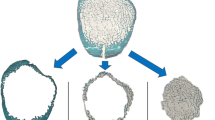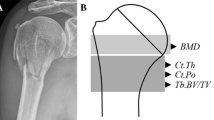Abstract
Fractures of the radial head are common; however, it remains to be determined whether the radial head has to be considered as a typical location for fractures associated with osteoporosis. To investigate whether the human radial head shows structural changes during aging, we analyzed 30 left and 30 right human radial heads taken from 30 individuals. The specimens taken from the left side were analyzed by peripheral quantitative computed tomography (pQCT) and micro-CT. The specimens taken from the right elbow joint were analyzed by radiography and histomorphometry. In these specimens pQCT revealed a significant decrease of total and cortical bone mineral density (BMDto BMDco) with aging, regardless of sex. Histomorphometry revealed a significant reduction of cortical thickness (Ct.Th), bone volume per tissue volume (BV/TV), and trabecular thickness (Tb.Th) in male and female specimens. In this context, mean BV/TV and mean trabecular number (Tb.N) values were significantly lower and, accordingly, mean trabecular separation (Tb.Sp) was significantly higher in female samples. The presented study demonstrates that the radial head is a skeletal site where different age- and sex-related changes of the bone structure become manifest. These microarchitectural changes might contribute to the pathogenesis of radial head fractures, especially in aged female patients where trabecular parameters (BMDtr and Tb.Sp) change significantly for the worse compared to male patients.





Similar content being viewed by others
References
Herbertsson P, Josefsson PO, Hasserius R, Besjakov J, Nyqvist F, Karlsson MK (2004) Fractures of the radial head and neck treated with radial head excision. J Bone Joint Surg Am 86:1925–1930
Herbertsson P, Josefsson PO, Hasserius R, Karlsson C, Besjakov J, Karlsson M (2004) Uncomplicated Mason type-II and III fractures of the radial head and neck in adults. A long-term follow-up study. J Bone Joint Surg Am 86:569–574
Mason ML (1954) Some observations on fractures of the head of the radius with review of one hundred cases. Br J Surg 42:123–132
Ikeda M, Sugiyama K, Kang C, Takagaki T, Oka Y (2005) Comminuted fractures of the radial head. Comparison of resection and internal fixation. J Bone Joint Surg Am 87:76–84
Radin EL, Riseborough EJ (1966) Fractures of the radial head. A review of eighty-eight cases and analysis of the indications for excisison of the radial head and operative treatment. J Bone Joint Surg Am 48:1055–1064
Gebauer M, Rücker AH, Barvencik F, Rueger JM (2005) Therapy for radial head fractures. Unfallchirurg 108:657–667
Brown SA, Rosen CJ (2003) Osteoporosis. Med Clin North Am 87:1039–1063
Rodan GA, Martin TJ (1981) Role of osteoblasts in hormonal control of bone resorption—a hypothesis. Calcif Tissue Int 33:349–351
Schneider P, Reiners C, Cointry GR, Capozza RF, Ferretti JL (2001) Bone quality parameters of the distal radius as assessed by pQCT in normal and fractured women. Osteoporos Int 12:639–646
Amling M, Herden S, Pösl M, Hahn M, Ritzel H, Delling G (1996) Heterogeneity of the skeleton: comparison of the trabecular microarchitecture of the spine, the iliac crest, the femur, and the calcaneus. J Bone Mineral Res 11:36–45
Parfitt AM, Drezner MK, Glorieux FH, Kanis JA, Malluche H, Meunier PJ, Ott SM, Recker RR (1987) Bone histomorphometry: standardization of nomenclature, symbols, and units. Report of the ASBMR histomorphometry nomenclature committee. J Bone Miner Res 2:595–610
Amling M, Hahn M, Wening VJ, Grote HJ, Delling G (1994) The microarchitecture of the axis as the predisposing factor for fracture of the base of the odontoid process. A histomorphometric analysis of twenty-two autopsy specimens. J Bone Joint Surg Am 76:1840–1846
Amis AA, Miller JH (1995) The mechanisms of elbow fractures: an investigation using impact tests in vitro. Injury 26:163–168
Kimmel DB (1993) A paradigm for skeletal strength homeostasis. J Bone Miner Res 8:515–522
Ross PD, Wasnich RD, Davis JW (1990) Fracture prediction models for osteoporosis prevention. Bone 11:327–331
Currey JD (2003) The many adaptations of bone. J Biomech 36:1487–1495
Keaveny TM, Hayes WC (1993) A 20-year perspective on the mechanical properties of trabecular bone. J Biomech Eng 115:534–542
Eckstein F, Kuhn V, Lochmüller EM (2004) Strength prediction of the distal radius by bone densitometry—evaluation using biomechanical tests. Ann Biomed Eng 32:487–503
Lochmüller EM, Kristin J, Matsuura M, Kuhn V, Hudelmaier M, Link TM, Eckstein F (2008) Measurement of trabecular bone microstructure does not improve prediction of mechanical failure loads at the distal radius compared with bone mass alone. Calcif Tissue Int 83:293–299
Gebauer M, Lohse C, Barvencik F, Pogoda P, Rueger JM, Püschel K, Amling M (2006) Subdental synchondrosis and anatomy of the axis in aging. A histomorphometric study on 30 autopsy cases. Eur Spine J 15:292–298
Rupprecht M, Pogoda P, Mumme M, Rueger JM, Püschel K, Amling M (2006) Bone microarchitecture of the calcaneus and its changes in aging: a histomorphometric analysis of 60 human specimens. J Orthop Res 24:664–674
Müller R (2003) Bone microarchitecture assessment: current and future trends. Osteoporos Int 5:89–95
Gordon KD, Duck TR, King GJ, Johnson JA (2003) Mechanical properties of subchondral cancellous bone of the radial head. J Orthop Trauma 17:285–289
Eckstein F, Jacobs CR, Merz BR (1997) Mechanobiological adaptation of subchondral bone as a function of joint incongruity and loading. Med Eng Phys 19:720–728
Eckstein F, Muller-Gerbl M, Steinlechner M, Kierse R, Putz R (1995) Subchondral bone density in the human elbow assessed by computed tomography osteoabsorptiometry: a reflection of the loading history of the joint surfaces. J Orthop Res 13:268–278
Koslowsky TC, Mader K, Brandenburg A, Hellmich M, Koebke J (2008) Subchondral bone density of the radial head measured with subtraction densitometry. Surg Radiol Anat 30:113–118
Formica CA, Nieves JW, Cosman F, Garrett P, Lindsay R (1998) Comparative assessment of bone mineral measurements using dual X-ray absorptiometry and peripheral quantitative computed tomography. Osteoporos Int 8:460–467
Grampp S, Lang P, Jergas M, Glüer CC, Mathur A, Engelke K (1995) Assessment of the skeletal status by peripheral quantitative computed tomography of the forearm: short-term precision in vivo and comparison to dual X-ray absorptiometry. J Bone Miner Res 10:1566–1576
Ashe MC, Khan KM, Kontulainen SA, Guy P, Liu D, Beck TJ, McKay HA (2006) Accuracy of pQCT for evaluating the aged human radius: an ashing, histomorphometry and failure load investigation. Osteoporos Int 17:1241–1251
Acknowledgements
The authors acknowledge the support of Claudia Mueldner for excellent technical assistance in preparing the samples for qualitative and quantitative histomorphometry.
Author information
Authors and Affiliations
Corresponding author
Additional information
Matthias Gebauer, Florian Barvencik and Marcus Mumme contributed equally to this work.
Rights and permissions
About this article
Cite this article
Gebauer, M., Barvencik, F., Mumme, M. et al. Microarchitecture of the Radial Head and Its Changes in Aging. Calcif Tissue Int 86, 14–22 (2010). https://doi.org/10.1007/s00223-009-9304-0
Received:
Accepted:
Published:
Issue Date:
DOI: https://doi.org/10.1007/s00223-009-9304-0




